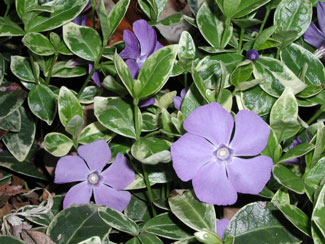Resource Library
Plant of the Week: Vinca Minor 'Ralph Shugert'
The University of Arkansas System Division of Agriculture does not promote, support or recommend plants featured in "Plant of the Week." Please consult your local Extension office for plants suitable for your region.
Plant of the Week
Vinca Minor 'Ralph Shugert'

About 20 years ago when I began installing my current garden, I added a groundcover planting of a variegated Vinca as a skirt amongst some azaleas.
The Vinca did wonderfully from the start and occupied the ground allotted with little spillover into adjacent areas. As often happens I never knew its true identity but recognized and appreciated its merits. Now, delving into its true identity, I understand why it has been such an outstanding plant.
It turns out that the groundcover is actually a white variegated sport of an old friend, Vinca minor ‘Bowlesii’ (also known as ‘Bowles’ or ‘La Grave.’ This old-time favorite, probably the best and most vigorous of the green-leafed Cincas, is thought to be a chance hybrid between Vinca minor and Vinca major. ‘Ralph Shugert’ (pp. 6960) was patented by David Mackenzie, a nurseryman from Spring Lake, Mich., who discovered it in 1986 and named it after fellow Michigan plantsman, Ralph Shugert.
Ralph Shugert Vinca is similar to the green leafed Vincas in that it is mat-forming and grows to about 6 inches tall. It has opposite, white-margined variegated leaves that indicate that the epidermal layer is devoid of chlorophyll. Because of the position of the variegation, the green centers of the leaves are more gray-green in color than the typical blue-green of the typical non-variegated Vinca. Because of the lack of chlorophyll, Ralph Shugert is not as vigorous as ‘Bowles’, but it is no slow-growing wimp that must be pampered.
Vinca belongs to the dogbane family and is native throughout much of Europe and parts of Central Asia. It is widely naturalized in much of North America, almost always associated with old home sites. A poem by Englishman Edward Thomas (1878 – 1917) goes:
“There once the walls
Of the ruined cottage stood,
The periwinkle crawls
With flowers in her hair, into the wood …”
For me, Ralph Shugert vinca has been less floriferous that ‘Bowlesii’ but that could be because of too much shade or somewhat dry conditions in the azalea bed. The flowers that do appear are to 1.5 inch across and light blue in color. Vinca does not produce seed, spreading only by runners.
Vinca goes under the common name of periwinkle because an old Latin name for the plant was Vinca peravinca – derived from “vincio,” the Latin “to bind.” During the late Middle Ages in the British Isles, “peravinca” became “paravink” which was eventually transliterated into the common name used today. In 1306, Simon Fraser, a supporter of Sir William Wallace who was a principle warrior in the fight for Scottish independence, was taken through the streets of London in chains on the way to his execution with a garland of periwinkle on his head, a revival of an old Roman practice.
Vinca is hardy from zone 4 through 8 with hybrids such as ‘Bowles’ and ‘Ralph Shugert’ doing better in more southerly locations such as Arkansas. It is best suited to light shade in well-drained sites. It should not be planted in confined locations or in locations where its expansion over the next decades will be problematic.
In the garden, Vinca spreads slowly but relentlessly and unless restrained by some physical barrier such as too much sunlight, it will continue to occupy more ground each decade. It seems to spread mainly down slope or sideways on slopes where it does best because of the good drainage it requires. Around old home sites it is not uncommon to see an almost pure stand of Vinca occupying the forest floor, only interrupted here or there by trees. It provides an unbroken stand so dense that only tree seedlings seem to be able to establish in its shade. It will not climb tree trunks like ivy plants.
By: Gerald Klingaman, retired
Retired Extension Horticulturist - Ornamentals
Extension News - May 10, 2013
The University of Arkansas System Division of Agriculture does not maintain lists of retail outlets where these plants can be purchased. Please check your local nursery or other retail outlets to ask about the availability of these plants for your growing area.